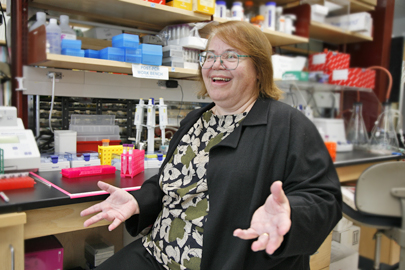Marder receives awards for neuroscience advances
Prizes from American Philosophical Society, Cognitive Neuroscience Society
 Photo/Mike Lovett
Photo/Mike LovettDivision of Science head Eve Marder, the Victor and Gwendolyn Beinfield Professor of Neuroscience
The Victor and Gwendolyn Beinfield Professor of Neuroscience has just added two more awards to add to her CV -- the George A. Miller Prize in Cognitive Neuroscience from the Cognitive Neuroscience Society (CNS) awarded March 31 and the Karl Spencer Lashley Award in Neuroscience presented on April 20 by the American Philosophical Society (APS).
“I was very surprised to receive the Miller Prize because I’m not a cognitive neuroscientist!” says Marder. “Cognitive neuroscientists study the human brain using either behavioral or imaging methods, such as functional magnetic resonance imaging, to try and understand the performance of the human brain.”
Seeing that Marder learns from lobsters and crabs, it’s understandable that she was surprised. She says she suspects that her work was selected because in recent years her lab has been studying the biological basis of animal-to-animal variability -- in other words, asking how different the underlying structures of each animal’s brains can be and still produce stereotypical or recognizable behavior.
“We happen to study crabs, and the question is: How different can one crab brain be from another crab brain and still be healthy,” says Marder. “This question is one that is obviously fundamental to understanding both the commonalities and the differences in human brain structure function.”
Marder says if you really want to understand the highest levels of human performance and cognition, and what the boundaries between health and disease are, you have to understand how different two brains can be and still be healthy; what kinds of differences would cause a brain to go from health to disease?
In the first part of her career Marder studied how neuromodulatory substances —the chemicals in the human brain — alter the function of brain circuits in order to produce different behaviors at different times; substances like dopamine or serotonin that in humans are very important for arousal and mood and emotion. She studied, at a very basic level, how those substances alter the properties of neurons or synapses so that circuits change their performance.
Marder learned that many different neuromodulatory substances were active and could reconfigure neural circuits. This work is also directly relevant to understanding how neuromodulators alter the function of the human brain.
One of the questions that Marder has been studying in her lab over the last 20 years is fundamental to every nervous system, whether it’s human or animal.
“Every membrane protein turns over, yet a neuron itself can live for a hundred years,” says Marder. “The question is what sorts of processes keep that neuron functional even though it’s constantly replacing all of its pieces.”
Marder says that some of the general principles that her lab has elucidated over the last 35 years have turned out to be relevant to disorders like epilepsy, seizure, chronic pain syndrome and a variety of other major human diseases.
“Sometimes you can start out to ask one fundamental question, and you gain insight into something very far from where you started,” says Marder.
Recently her lab has been focusing on the question of individuality — how each animal may find a different solution to producing very similar neuronal function.
Marder says crustaceans provide a very useful platform for these studies because the stomatogastric ganglion in lobsters and crabs contain only 30 neurons and therefore it’s easy to see when something has changed. In other words you can record the same cell from animal to animal, day in and day out.
Most recently Marder has been studying the effects of temperature on the crab stomatogastric nervous system. She says a remarkable finding that her lab has made is that the animals could produce very reliable motor patterns over a fairly large range of temperatures, but if they go to even slightly higher temperatures, the nervous system becomes unable to perform. Currently the lab is looking at the ways in which high temperatures alter the nervous system as an assay as to how the animals are different.
“The experience that we have as scientists is that it never ends,” says Marder.
“Every time you answer a question it raises others.”
The George A. Miller Prize in Cognitive Neuroscience was established in 1995 by the Cognitive Neuroscience Society to honor the innovative scholarship of George A. Miller, whose many theoretical advances have greatly influenced the discipline of cognitive neuroscience. The Prize is awarded to the nominee whose career is characterized by distinguished and sustained scholarship and research at the cutting edge of their discipline and who has in the past, or has the potential in the future, to revolutionize cognitive neuroscience.
The Karl Spencer Lashley Award, established in 1957 recognizes work on the integrative neuroscience of behavior. Lashley’s experiments on the brain mechanisms of learning, memory and intelligence helped inaugurate the modern era of integrative neuroscience.
Categories: Research, Science and Technology





